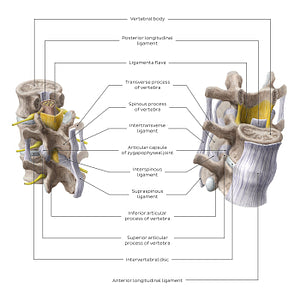Liene Znotina
Joints and ligaments of the vertebral bodies and arches (English)
Joints and ligaments of the vertebral bodies and arches (English)
Intervertebral joints are articulations between adjacent vertebrae of the spine. An intervertebral symphysis is the articulation of two contiguous vertebral bodies and the intervening intervertebral disc. It is classified as a secondary cartilaginous joint or symphysis (fibrocartilage composition). Vertebral bodies in the cervical region also articulate at uncovertebral joints (of Luschka). These comprise four pairs of plane synovial joints present between the vertebrae C3-C7, along the lateral borders of their vertebral bodies. A zygapophyseal joint (facet joint) is a synovial joint formed by the articular processes of neighboring vertebrae. Both intervertebral disc and zygapophyseal joints extend between the levels of the axis (C2) and sacrum (S1). The intervertebral joints are reinforced and supported by numerous ligaments.The anterior and posterior longitudinal ligaments extend along the anterior and posterior surfaces of the vertebral bodies and interposed intervertebral discs, respectively. The ligamenta flava can be seen on the posterior surface of the vertebral canal, extending between adjacent laminae. The inferior articular processes of each vertebra articulates with the superior articular processes of its neighbor below, forming two zygapophyseal (facet) joints at each vertebral level; each is surrounded by an articular capsule. Other ligaments extend between different bony processes of the adjacent vertebrae, namely the intertransverse ligament (between transverse processes) and interspinous and supraspinous ligaments (between spinous processes).
Preço normal
$7.56 USD
Preço normal
Preço promocional
$7.56 USD
Preço unitário
por
Não foi possível carregar a disponibilidade de retirada.


#E2CE33
#AA9761
#6A551F
#554639
#E0D594 e #D3CCAE

